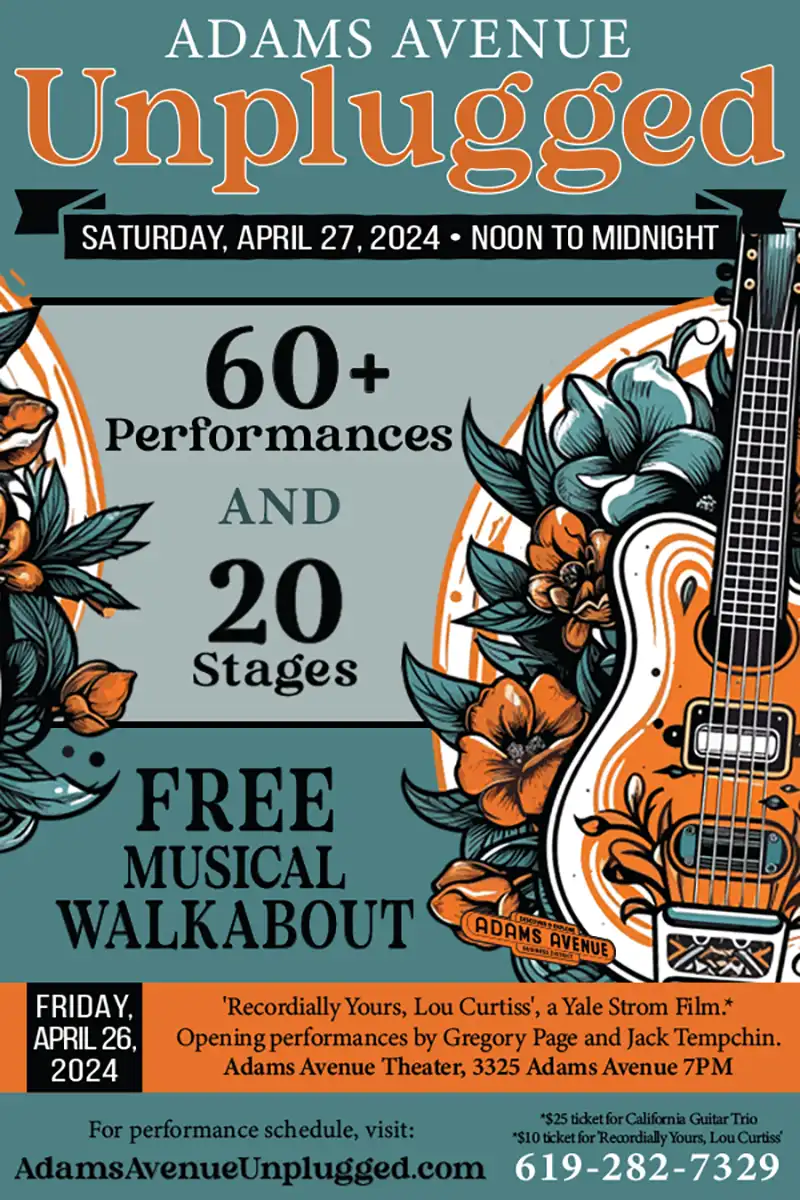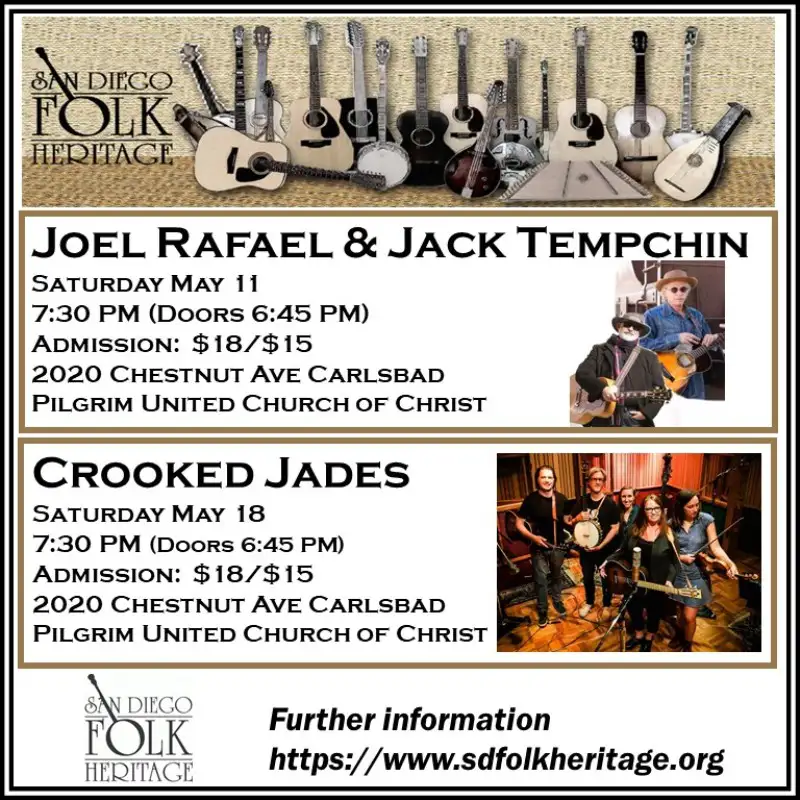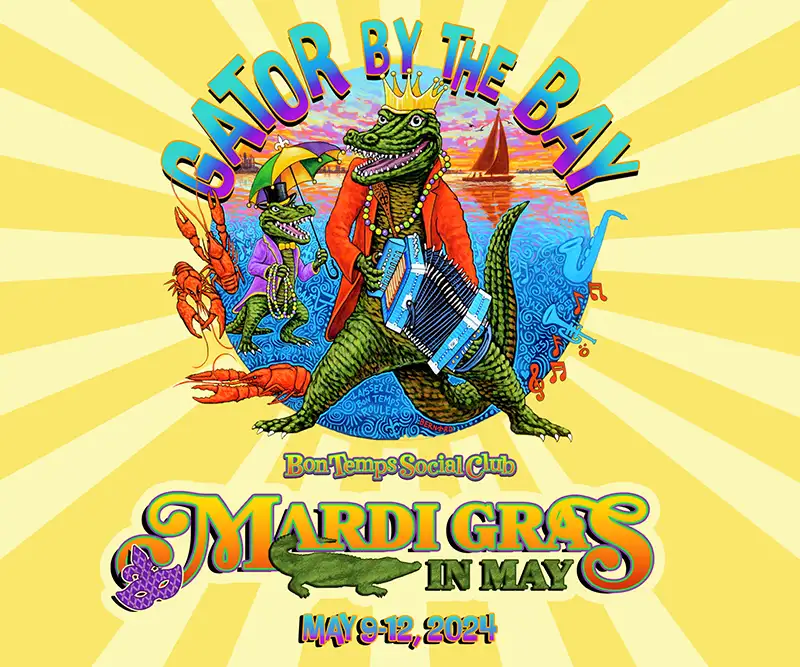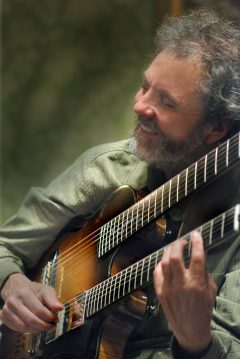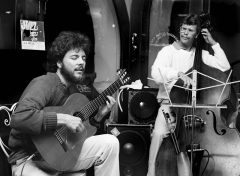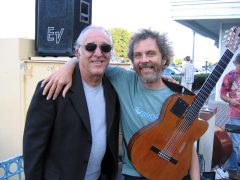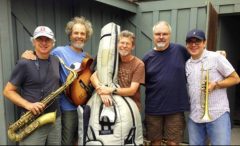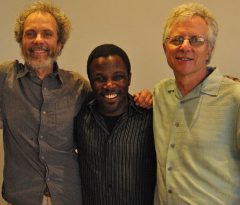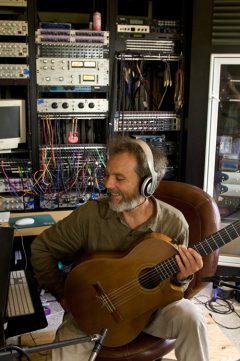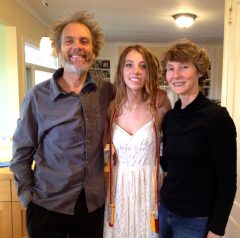Cover Story
PETER SPRAGUE: Life in the Wild Blue
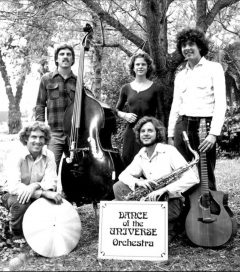
Dance of the Universe Orchestra: Kelly Jocoy, Fred Rath, Kevyn Lettau, Tripp and Peter Sprague, circa 1975.
When I first experienced Peter Sprague back in 1977, playing an outdoor concert at Robb Field in Ocean Beach with his group Dance of the Universe, it was a game-changer for me as a young, aspiring jazz guitarist.
They opened the concert by playing John McLaughlin’s “Le Danse du Bonheur” (The Dance of Bliss), a tune I considered to be impossible to reproduce—yet these youngsters pulled it off.
Peter was just back in San Diego after spending a summer in Boston, where he audited classes at the Berklee College of Music while taking private lessons with Pat Metheny and classical music legend Madame Chaloff.
I was hooked and, from there on out, I tried to catch Peter in every possible permutation. I saw him with saxophonists Joe Marillo and Charles McPherson, with pianists Butch Lacy and Bill Mays, with bassist extraordinaire Bob Magnusson and, of course, with his own band Dance of the Universe, featuring Peter’s brother Tripp on saxophone, John Leftwich on bass, Kelly Jocoy (followed by Kevin Koch) on drums, and the amazing young singer Kevyn Lettau on vocals.
When Peter’s band established a residency at Elario’s (top floor of the Summer House Inn) in La Jolla, I went several times a week. I learned to love standards and the Great American Songbook from watching them perform, and I still think of so many tunes that I phrase in my brain the way Kevyn sang them.
For years I watched Peter like a hawk—mesmerized by the acuity in which ideas flowed from his brain into his incredibly graceful fingers. To this day, I have never seen any other guitarist whose digital choreography is more inspiring—and I’ve seen all of the world’s greatest guitarists at least once.
San Diego music fans can be thankful for Peter’s love of the ocean and the art of surfing. Because of that connection, he has eschewed the brighter lights of New York City and Los Angeles—although, truth be told—Sprague did live for a while in both towns, always to return to the lure of the “Wild Blue,” his descriptive reference to the Pacific Ocean and, coincidentally enough, the title of a sterling recording by the Peter Sprague String Consort, one of the myriad of project irons he keeps in the fire.
After encountering a severe bout with tendonitis in the 1980s, Peter had to do some hard thinking in terms of his career in music. At that point, he invested a lot of time, money, and equipment into setting up Spragueland Studios in Leucadia. Hundreds of sessions have been produced there, and Peter has developed a well-deserved reputation as one of San Diego’s finest recording engineers and producers.
He might have scaled back his obsessive practice routine a tad, but Sprague remains a veritable whirlwind of activity. He plays solo gigs, duets with vocalist Leonard Patton, a collaboration with singer Rebecca Jade called Planet Cole Porter, and is debuting a brand new composition, commissioned by Chamber Music America with Bridget Dolkas on violin, Lars Hoefs on cello, and Duncan Moore on drums.
***************
It’s been such a joy to make music with Peter for over 50 years! Since we’ve pretty much taken a similar musical path, exposed to the same influences, a lot of the same things in music give us a thrill, like when we hear Sonny Rollins and Coltrane trading 4s on “Tenor Madness” or Pat Metheny play “The First Circle.” I think we also inspire each other with musical ideas or fresh chops.
—Tripp Sprague
***************
In the beginning, there was music in the Sprague house…
“It was largely coming from our father. My dad and his brother were really into jazz. So, when Tripp and I were growing up there was always music by Miles Davis or Benny Carter. That stuff was always playing on the stereo—we didn’t really understand it, but years later, when we started to learn jazz—it must have seeped in, because I think we had a natural affinity for it. My dad didn’t just dig playing it on the stereo, he would also take out his bongos and play along. Our mom played piano a little and we always had an upright piano in the house. The great thing about the piano if it’s in tune, it sounds like music right out of the gate.”
Like most kids of his generation, Peter’s initial inspiration to play music came from the four mop-topped lads from Liverpool, aka the Beatles. “We have an older sister, Terry, and her friends were really into the Beatles. We got exposed to that through them and also Jimi Hendrix, Cream, and Crosby, Stills & Nash—all of them were a big influence on us. But our first love was the Beatles—even to this day, their songs convey so much emotion to me. I started playing guitar when I was 12, and my interest was definitely keyed on rock music.”
Getting more serious about music…
“At first I was not too devoted to the guitar; I was probably more serious about surfing, which I thought might be a possible career. I didn’t really practice, but some of my friends thought I sounded good. When I got to high school, I connected with the great pianist Rob Schneiderman, bassist John Leftwich, drummer Kelly Jocoy, plus Tripp and myself (The Minor Jazz Quintet), and we started discovering jazz, listening to my dad’s records and doing little gigs. I started to get more serious about music, so for my senior year in high school, I decided to go to the Interlochen Arts Academy, in Michigan. I’m really lucky that my folks got behind the idea and were willing to pay for me to go. It was a big step—moving away from the comfort of Del Mar and going all the way to the Midwest.
“But it was an amazing time. I was surrounded by brilliant young musicians way beyond my ability, which spurred a desire in me to get better and study hard, and it was a real turning point—getting out of my comfort zone in Del Mar where my friends and I all thought I was good. At Interlochen I realized how much work I needed to do.”
After his year in Michigan, Peter returned home, but not for long.
***************
Peter is amazing. I have known him for years and have always thought of him as one of the best. A great musician who also happens to be a great guitar player. With Peter I always hear the music first. His amazing touch on the instrument is always present whether on electric or acoustic. His duet playing with Leonard Patton is astonishing to me. The level of precision and discipline he brings to that setting is something that he makes seem easy, but is in fact one of the most difficult things a guitarist can be asked to do. He is absolutely masterful at it.
Additionally, everyone who knows Peter knows him as a truly wonderful person. He brings his San Diego-ness to each note and is maybe the best musical ambassador the area could ever have. Peter is a surfer and brings the wisdom that I can only assume comes from a life spent out on the waves to his improvising—somehow you can hear all that in there.
I am always flattered that Peter takes time to come to my gigs when I head out that way and his presence is always inspiring to me. Knowing that those great ears are out there checking out the music always makes me want to aim higher.
—Pat Metheny
***************
The Boston hang…
“My friend Rob Schneiderman was going to the Berklee College of Music and he convinced me to go with him to Boston. We became roommates, and I started auditing classes because I was thinking maybe that was the next step. At that time Pat Metheny was teaching at Berklee—it was right before he got super famous, but in Boston he was already creating quite a stir. He was playing around town with the trio that recorded Bright Size Life (Jaco Pastorius and Bob Moses). I heard them and it blew my mind, so I called Metheny up and took a few lessons from him and it was super inspiring.”
As much fun and inspiration the Boston music scene provided, Peter came to an important realization about music and music school.
“I became real convinced that going to Berklee wasn’t the path I wanted to pursue. I realized that I had had enough of school, and that I should just ‘go to the room,’ as I called it and just practice. I wanted to be doing it as opposed to sitting in a classroom and talking about it. It was cool because my folks were behind my decision.”
Returning to San Diego and the birth of the Dance of the Universe
That move enabled this writer’s 19-year-old self to get his mind blown all those years ago in Ocean Beach. “That was a big deal for us, too. But as time marches forth, I run into other people who were also moved by those early shows. Maybe we were really good, but we were also very young and that was probably a part of the allure. We were all dead serious about it and we were kind of searching for our place in the music.
“Our first gigs were mainly playing on little street corners in Del Mar. On Sunday’s we would set out a guitar case on the sidewalk—and it became really successful—even though we didn’t really have a business model in mind. We just kind of played it by ear, because we were mostly preoccupied with practicing and getting better on our instruments.”
Where did the idea for the name of the band originate?
“I think I might have come up with the name. We were all sharing the same books at the time, and one of the real important ones was Be Here Now, by Ram Dass. In the book he’s always saying that you need to be in tune with the dance of the universe. One Sunday we put that name on the chalkboard where we were playing, and it just kind of fit. We actually made a record back then, when that was an unusual thing to do, because there weren’t too many studios and they were expensive. We got Butch Lacy involved and we went for it and spent the money, and from that record we got a lot of great gigs. We played at a jazz street festival on India Street that actually got written up in Downbeat magazine where they described us as a ‘really young band of spirited musicians!’ I do remember that was a pretty hot set we played.”
***************
Peter Sprague is a wonderful musician who is both creative and dedicated. He has a flowing creative line in his improvisations.
—Charles McPherson
***************
Getting inspired from the records of Bird, Sonny Rollins, and John Coltrane
At that point in his life, Peter was drawing heavily upon the influences of three major innovators, beginning with the legendary alto saxophone master Charlie Parker. “Parker was one of the first guys that I really connected with—I was just knocked out and I started to really study his music. That’s when I learned why it was so good. Those were perfect notes, perfect color and super melodic—great sense of humor. I was really touched by his music.”
What did you dig about Sonny Rollins?
“It felt like a natural progression from Parker to Rollins. They had a similar vibe, but Sonny probably upped the ante even higher with the humor in his improvising. His sense of time is just incredible and I really connected with him as well. Also, later in his life he got into yoga—I like that combination of music and yoga, because I’m into that as well.”
And, finally, what was it about the music of John Coltrane that pulled you in?
“John Coltrane was someone I was afraid of in the very beginning. It was so heavy at first, but as time marched on, he became one of my all-time favorite musicians. His conviction and the power in the language he speaks is so deep and yet so humble; he was just brilliant. To this day, I devour his music and I still consider him to be one of my main inspirations.”
***************
Peter is an amazingly creative artist with a beautifully humanistic viewpoint and lifestyle. He’s definitely a brother on our tacit mission to uplift our environment and spread the joy of creating.
—Chick Corea
***************
Meeting Chick Corea and much more
“I first heard Chick’s Light as a Feather LP when I was still in high school, and it was transformational. I started trying to learn all of those songs and transcribe those solos. When I was at Interlochen I even wrote Chick a letter, asking him for the sheet music for some of the tunes I couldn’t get and he was very approachable. I even told him if he ever needed a guitar player, I was his man! Which was pretty hilarious coming from a high school kid who was still trying to memorize scales and arpeggios.”
How did you meet him?
“I was at a Chick Corea concert at Humphrey’s with Bob Magnusson, I think, and afterward Bob introduced me because they had played together. He really wanted Chick to be aware of me, and I’ll always be grateful for that.
“Later on, when I got a record contract with Xanadu Records, I did a solo medley of a bunch of Chick tunes, and the producer, Don Schlitten, asked Chick to check it out and write something for the liner notes. Shortly thereafter, Chick invited me up to his house in L.A. Every year he put on this party for Valentine’s Day and, at the time, Chick was living in a castle near Griffith Park. He had this enormous living room with two grand pianos, and these parties were epic events with people like Herbie Hancock, Al Jarreau, and Wayne Shorter, plus poets and actors and even a small orchestra. I was invited up and I played a duet with John Leftwich. Shortly thereafter, Chick called me to join his band, which I did for about a year, and it was a real high point in my life. The band featured Chick, of course, me, this guy Jamie Faunt on electric bass, Tom Brechtlein on drums, Chick’s wife Gayle Moran on vocals, and Al Jarreau joined us for a few concerts and, like I said, playing with Chick was like a dream come true.
“Some time later, I put out a book of transcribed Chick solos and at that point, the technology for music notation software became available, and I immediately went out and invested in that. I ended up transcribing the charts for about four or five of Chick’s albums.”
Teaching the instrument at G.I.T. and CalArts
Even though Peter decided to avoid the music school route for himself as a player, his obvious chops were bound to attract the attention of educational programs everywhere, and our man soon found himself teaching at not one, but two schools up north.
“Yeah, that was a neat time for me. I was still living down here and I got a call from Bob Magnusson, who was teaching up there and he must have told them about me. I loved coming into contact with all these up-and-coming players who had a lot of talent. I really connected with the instructors there like Billy Childs who taught keyboards, Scott Henderson and Frank Gambale, and Joe Diorio were on staff, and Pat Metheny would often come through and do workshops. It was a great experience, all in all.”
Sprague was busy with students at Guitar Institute of Technology (later renamed the Musicians Institute) when he got the call from the prestigious CalArts (California Institute of the Arts). “I forget who set it up, maybe the flute player Steve Kujala, but the director called and said they had a job for me. At that point, I moved up to L.A. I had been commuting until then, but once I was teaching at both schools it made sense. The CalArts thing was very progressive—they had Charlie Haden and James Newton on staff. So that was great, but eventually, L.A. started to wear on me. The CalArts thing was about to morph into a full-time position, and the money and benefits were very good—which could have solved a lot of problems. It was a really hard decision to make, but ultimately I couldn’t see making a career out of teaching, so I decided to leave. Half of teaching is Psychology 101, you know, having to ask students why they didn’t practice. It all worked out for the best, because they ended up replacing me with Larry Koonse—who I’m super fond of—he’s made a whole career out of it and he loves it.
“So, I was interested in recording technology, and once I made the decision to leave the academic world, I needed to figure out how to make a living apart from doing lots of gigs. I decided to set up a home studio, because one thing I’ve noticed is that people are always on their best behavior when they come to a studio. And the recording thing was more interesting to me, so I went in that direction.”
***************
We’ve been playing together for 41 years; it’s been an amazing ride. He’s always been one of the most organized and professional and hardworking people I’ve ever worked with in this business. He expects you to give it your all, but you’ll never meet a nicer guy.
—Duncan Moore
***************
Playing with another legend: Charlie Haden
One of Peter’s most exciting gigs for me as a listener happened after he came back to San Diego and was enlisted by bassist Charlie Haden (most known for his groundbreaking work with Ornette Coleman). Haden was experimenting with a new band featuring guitar and piano and bebop veteran Lawrence Marable on drums. It was an early version of what would eventually become Haden’s Quartet West. This band, which also featured San Diego legend Mike Wofford, played a two-week engagement at Elario’s in La Jolla, and I consider myself very lucky to have witnessed it.
“That was such a cool moment, I had met Charlie at CalArts, but we didn’t play up there. He wanted to put together a new group and he really wanted Pat Metheny to come to the West Coast and do it. But Pat couldn’t make the gig, so Charlie asked him for a recommendation and Pat said he should get me. So, Charlie called and he sent me the songs—we rehearsed one day before the gig and then it was just two weeks of incredible music. Charlie has such an amazing connection with the history of the music—especially with Ornette Coleman, Metheny and Old & New Dreams, and all of those people. We would be playing a tune by Charlie Parker and then Haden would solo and go off the written page and get into some deep Appalachian folk music, or jump to free form. It just felt hypnotic and beautiful, and it was a real high point for me. You know I don’t usually play very ‘free’ but through Charlie’s influence, both Mike and I kind of loosened up the reins of harmony and played a little more ‘outside’ than usual. It was an exciting time, and I’ve heard that there is a recording out there somewhere.”
When practice turns painful: the struggle with tendonitis
Even though his gift is to make it all look so effortless, I can attest from my time as a student of Peter’s that tons of effort are required to even get within miles of that degree of virtuosity. His practice routine is legendary. When he was spending a lot of time stuck in L.A. traffic, he kept a guitar in the car to work on technical exercises while he waited. Consequently, it didn’t come as a huge shock to me when he developed hand problems in the late 1980s.
“Part of why I decided to leave CalArts and Musicians Institute was that I started having problems with a few of my fingers. The tendons in my right hand started hurting and I was thinking ‘what’s up with that?’ So, I initially thought I needed to work harder, which is a kind of a bullheaded male reaction. My lovely wife, Stef, is a hand therapist and she sees that kind of thing all the time. But of course overdoing it makes it even worse. I remember being on tour with Kevyn Lettau and her husband at the time, Mike Shapiro; my hand really started acting up, so I sought medical advice. At first it looked like common tendonitis, but after getting blood tests and other diagnostics, it turns out that it’s a genetic issue called psoriatic arthritis and it’s systemic, meaning that it affects your whole body. It’s a deal where your immune system is sort of attacking itself. I took six months off, but other things started cropping up. I used to be a runner and then my feet started to hurt. So, I really had to start thinking about what might happen if I wasn’t going to be able to play again. That’s really when the recording studio idea became more serious. Well, you know, it’s not as much fun as playing gigs but it was a way to stay involved in music should I become disabled. For years I tried to only use holistic-type remedies and some of that stuff worked in small ways. Ultimately, I had to try what the doctors were recommending, which was traditional drugs. It was an amazing thing, because they really worked, and that made a huge difference in my life. So I decided to embrace them rather than avoid them and pay the consequences of potential side effects in order to live a life free of pain. So, I’m glad I made that choice, and I’m also glad that I checked out all of the alternatives. It’s still something that’s with me. It’s still a challenge, and there are still some limitations, and I have to be really careful. If I have gigs that day, I can’t practice for hours beforehand or I’ll wear myself out. But, you know, I make the best out of it and I still have a lot of fun playing music.”
***************
Where do I start? He’s been the biggest musical influence on my life for over 25 years. He’s a monster player, composer, and bandleader. There are very few musicians in the world who can do what he does and continues to do.
—Leonard Patton
***************
You make me want to sing
That was the name of the first Dance of the Universe album, featuring the teenaged songbird Kevyn Lettau, and from there on out Peter has collaborated with some of the finest singers on the planet. He’s worked with Denise Donatelli, Al Jarreau, Allison Adams Tucker, Diane Reeves, Leonard Patton, and Rebecca Jade, and that’s literally just the tip of the iceberg, He’s currently touring the Canary Islands as a duo with the amazing Danish vocalist Sinne Eeg. I had to ask where this deep affinity for singers came from.
“Well, there’s a couple of things at play for me with that. In the early days, we were playing a lot of standards, and I just love the way the melody gets expressed and the story gets told through a vocalist. I think that we, as instrumentalists usually try to bring out a vocal quality to our playing—but there’s nothing that can express that better than a singer. Another thing I like is the balance between playing kind of wild and having it all being grounded when the singer comes back in. It’s a universal connection for the audience. They might relate to me as a guitarist but most of them don’t really focus on that—but everyone has a voice that they speak with and people just relate more to singers, I think.”
Always look on the bright side of life…
I’ve known Peter Sprague all of my adult life. One of the things that continues to amaze me is his relentlessly positive attitude, which he’s demonstrated from the very beginning. It’s genuine and singular to the man himself. You can hear it in the way he talks or writes his weekly newsletter. A wonderful blend of surfer-speak, bebop slang, and Eastern mysticism that coming from anyone else would sound trite or insincere. But in Peter’s voice, it’s pure melody. Where did all of that positive energy come from?
“If I look back, I think I had really great parents who were fun and into the idea of letting their kids be who they wanted to be. I had fantastic siblings and I had this idyllic life that revolved around the ocean and music; it still does. Having early roots in that scene set this all into motion. I have a real appreciation for life and I think that set me off with the right spin. And now I have all of this plus a beautiful family of my own.”


